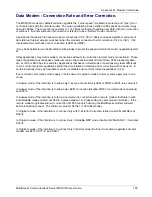
Glossary
MultiAccess Communications Server MA30120 User Guide 172
IP Packet
– A self-contained independent entity of data carrying sufficient information to be routed from the
source to the destination computer without relying on any earlier exchange between this source and destination
computer and the transporting network. The Internet Protocol (IP) is defined in RFC 791.
IP Payload
– The part of the IP packet that carries upper level application data.
Key
– A data string which, when combined with source data (packet) using a special algorithm, produces
output that cannot be read without that specific key. Key data strings are typically 40-168 bits in length.
Key Agreement
– A process used by two or more parties to agree upon a secret symmetric key.
Key Exchange
– A process used by two more parties to exchange keys in cryptosystems.
Key Generation
– The act or process of creating a key.
Key Management
– The various processes that deal with the creation, distribution, authentication, and storage
of keys.
Key Pair
– Full key information in a public-key cryptosystem; consists of the public key and private key.
L2TP
(
Layer Two Tunneling Protocol
)
– A security protocol that facilitates the tunneling of PPP packets
across an intervening network in a way that is highly-transparent to both end-users and applications. L2TP is
defined in IETF RFC 2661.
LILO (LInux LOader)
– LILO is a small program that sits on the master boot record of a hard drive or on the
boot sector of a partition. LILO is used to start the loading process of the Linux kernel. (There are other
programs that can also do this, such as
grub
. Most distributions / versions of Linux use LILO.) You can set up
lilo to require a password to start to load the Linux kernel, or you can set it up to require a password if you want
to pass any extra options to the Linux kernel before it starts loading.
Mapping
– Logically associating one set of values (such as addresses on one network) with values or
quantities on another set (such as devices on another network). Examples include name-address mapping,
inter-network route mapping, and DNAT port mapping. Name resolution (name to address mapping) is another
example.
Masquerading
– The concealing of internal network information (LAN) form the outside. For example, the
computer of a colleague with the IP address is inside a masked network. All the computers inside his network
are assigned one single, official IP address (i.e. if he starts an HTTP request into the Internet, his IP address is
replaced by the IP address of the external network card). This way, the data packet entering the external
network (Internet) contains no internal information. The answer to the request is recognized by the firewall and
diverted to the requesting computer.
MD5 (Message Digest 5)
– A one-way hashing algorithm that produces a 128-bit hash. It computes a secure,
irreversible, cryptographically strong hash value for a document. The MD5 algorithm is documented in IETF
RFC 1321.
Message Digests
– Mathematical functions (aka, one-way hashes) that are easy to compute but nearly
impossible to reverse. The message digest serves as a "fingerprint" for data. As such, it is an element of most
data security mechanisms (e.g., Digital Signatures, SSL, etc.). The hashing function takes variable-length data
as input, performs a function on it, and generates a fixed-length hash value.
MPPE (Microsoft Point-to-Point Encryption)
– An encryption technology developed by Microsoft to encrypt
point-to-point links. The PPP connections can be over a VPN tunnel or over a dial-up line. MPPE is a feature of
Microsoft's MPPC scheme for compressing PPP packets. The MPPC algorithm was designed to optimize
bandwidth utilization in supporting multiple simultaneous connections. MPPE uses the RC4 algorithm, with
either 40-bit or 128-bit keys, and all MPPE keys are derived from clear text authentication of the user password.
The MultiAccess supports MPPE 40-bit/128-bit encryption.
Name Resolution
– The process of mapping a name into its corresponding address.
Summary of Contents for MultiAccess MULTIACCESS MA30120
Page 1: ...MA30120 User Guide ...








































